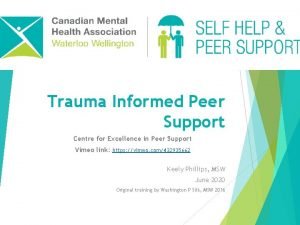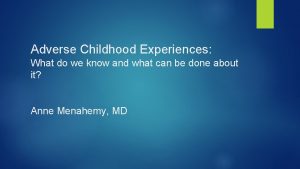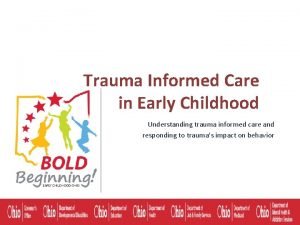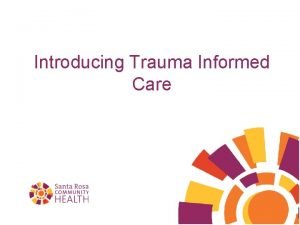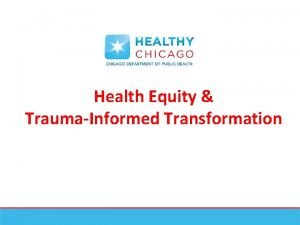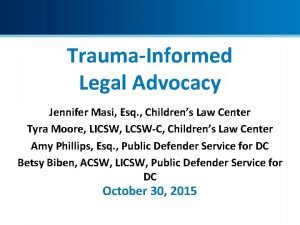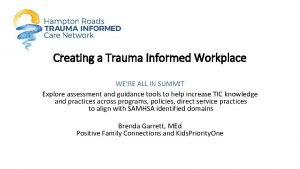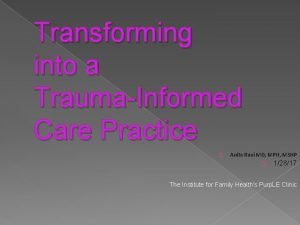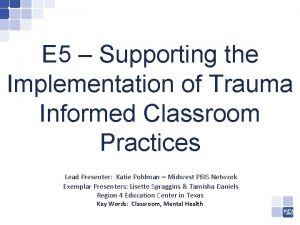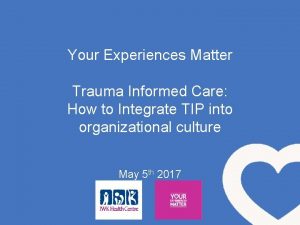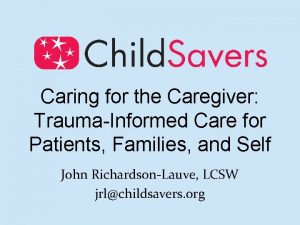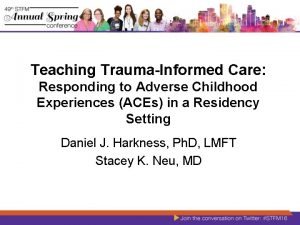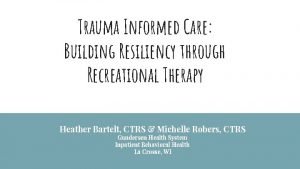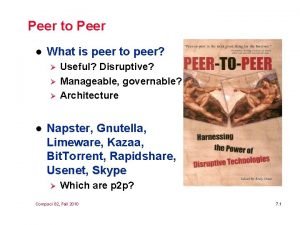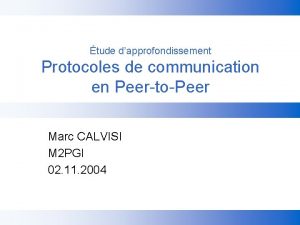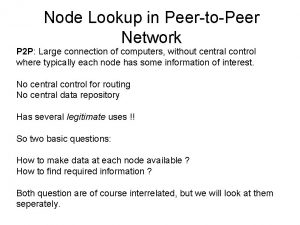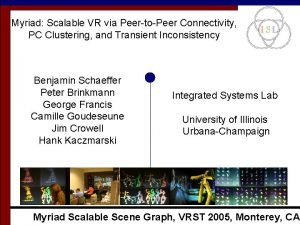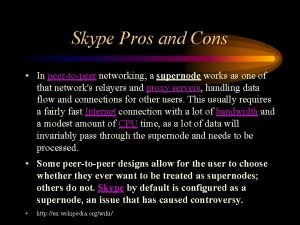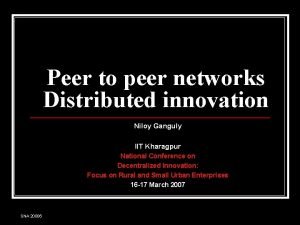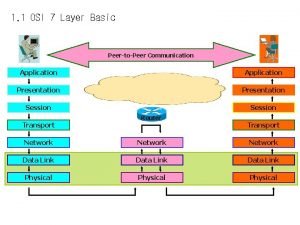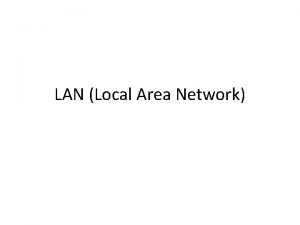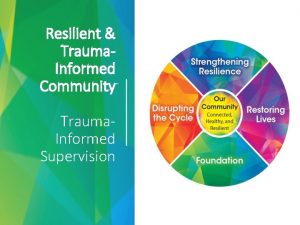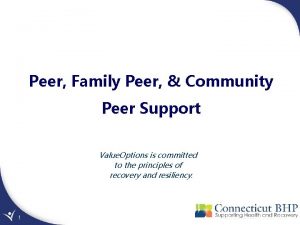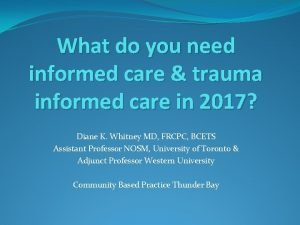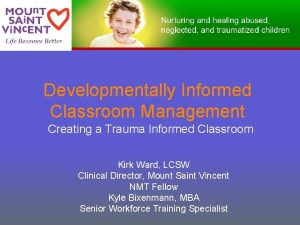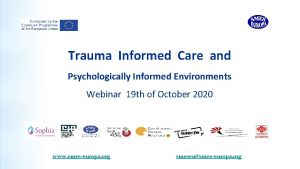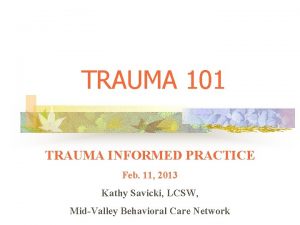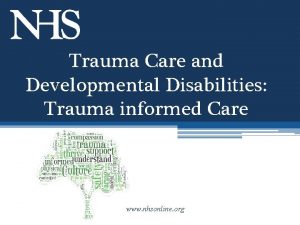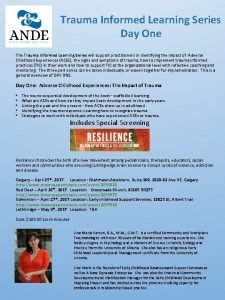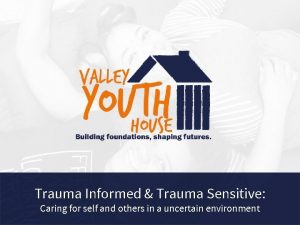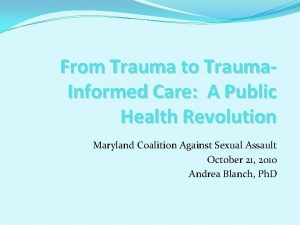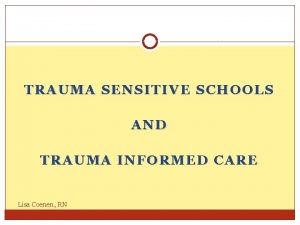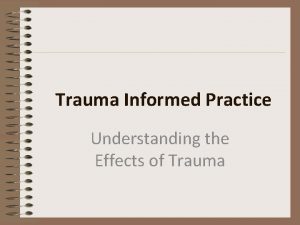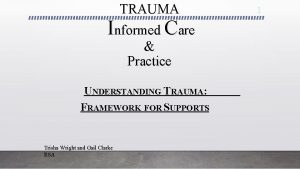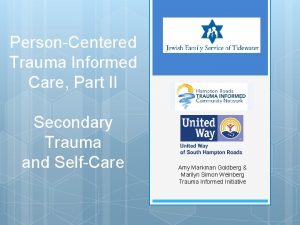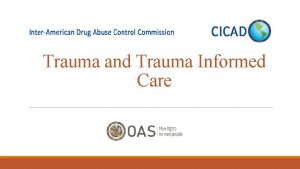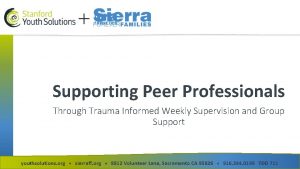Trauma Informed Peer Support Centre for Excellence in











































- Slides: 43

Trauma Informed Peer Support Centre for Excellence in Peer Support Vimeo link: https: //vimeo. com/432935662 Keely Phillips, MSW June 2020 Original training by Washington P Silk, MSW 2016

About Keely and the Centre for Excellence in Peer Support

Agenda What Is Trauma? Impacts of Trauma and Mental Health and Addiction Systems Peer Support & Trauma Informed Care Practices of Trauma Informed Peer Support Vicarious Trauma Informed Use of Lived Experience Practice Scenarios Recovery and Post Traumatic Growth

Trauma informed practice Trauma-informed practice means integrating an understanding of past and current experiences of violence and trauma into all aspects of service delivery. The goal of traumainformed systems is to avoid re-traumatizing individuals and support safety, choice, and control in order to promote healing. Is not trauma treatment.

What is Trauma?

What is Trauma? Is an emotional shock that overwhelms our abilities to cope making us go to into fight/flight or freeze response Normal response to abnormal situations Affects our brain chemistry Experincing a trauma can cause mental health distress, that gets labels like PTSD, DID, BPD, addiction

What is Trauma? The DSM 5 Defines it as… The person was exposed to: death, threatened death, actual or threatened serious injury, or actual or threatened sexual violence, as follows: 1. Direct exposure 2. Witnessing, in person 3. Indirectly, by learning that a close relative or close friend was exposed to trauma. 4. Repeated or extreme indirect exposure to aversive details of the event(s)

Not all traumatic events = trauma response for everyone WHY?



Window of Tolerance https: //www. psychologytoday. com/ca/blog/lifespanpsychology/202004/expanding-the-window-tolerance

Memory & Trauma…

What does it look like?

Who can experience Trauma? How? Individuals Families Communities

Why does being trauma informed matter in peer support?

Examples of community (systemic) trauma in the consumer survivor community… Historical Experiences Forced / coerced treatment Institutionalization No hope for recovery Plus all the current issues…. Current Experiences Lack of hope and compassion Stigma Difficulty finding and accessing help Poverty, unemployment, and inadequate housing Incarceration Lack of continuity with treatment / workers Lack of diversity of treatment options Wait times Medication and side effects Marginalization of certain groups and culturally unsafe practices Criminalization of drug use

Trauma Stats 10% of woman and 5% of men are diagnosed with PTSD Up to 1/3 of people exposed to trauma develop PTSD Trends show that men have higher rates of trauma but woman have more childhood trauma and are more likely then men to develop PTSD Of folks in substance abuse treatment, 12%-34% have current PTSD. For women, rates are 33%-59%. Gender plays a role: For women, typically a history of sexual or physical childhood trauma; for men, combat or crime. No Research has been done on Trans folks. PTSD associated with severe drugs; “self-medication” in 2/3 of cases (i. e. , PTSD first, then substance abuse)

Why Getting Help is Hard… Organizations PTSD are not trauma informed does not go away with abstinence Cannot be treated only within the medical model Still some separate treatment systems for mental health and addiction; not all help is publicly funded

Power and Privilege Power dynamics in society keep trauma experiences invisible: • Poverty • Racism • Ableism • Saneism • Homophobia • Stigma • Victim blaming • Child welfare systems

Experiencing Trauma Within the Mental Health System… When people do reach out for help they may have felt re-traumatized by some mental health responses ( eg loss of power and rights, seclusion and restraints, etc) it is not surprising to find that many people struggle or have complicated feelings when reaching out for help.

Core Principles of Trauma Informed Care Safety (Physical and Emotional) Trustworthiness Choice Collaboration Empowerment (Fallot & Harris, 2006) Peer Support Values and Principles Empowerment Hope Self Determination Elimination of Prejudice and Discrimination Meaningful Choice

Meet the Survivor Where They Are At See Adaptive Behaviors as Strength and with Purpose Minimize Re. Traumatization Builds on shared experience and mutual exchange Trauma Informed Peer Support Aim Provides reciprocal receiving and giving of support (Mead, 2008) Work with Survivors in a Collaborative Way with Mutual Goals Respect Voice and Choice Eliminates the power differential inherent in traditional mental health settings/clinical relationships Fosters relationships that establish new ways of understanding their experiences Facilitate Healing Understand the role of trauma in people’s lives Operate on an Empowerment Model

How does a peer worker do all that? Qualities essential to working with people who have experienced trauma Empathy Compassion Ability Willingness to learn Willingness to emotionally connect Ability to treat folks as equals Mutuality and collaboration to talk openly Self-care and honestly Self-awareness Flexibility Comfort ability with the unknown Doing your own emotional work

Approach and Language Not Trauma Informed • My illness • What is wrong with me? • My client/consumer • I am here to help you • Further along in recover (same as high and low function) • Coping • Safety is defined as risk management • Helpers decide what helps looks like • Relationship is based on problem-solving and accessing resources Trauma Informed • My Experiences • What has happened to me? • People I work with… • I am here to learn with you • Risking new thinking/ behavior • Change patterns • Safety is defined by the person • People choose the help they want • Relationship is based on autonomy and connection Adapted from Sherry Mead 2008

Peer Support is Unique Due to stigma you might be the first person they are reaching out to help understand their experiences: mutuality Offer an alternative to the medical model No assessments or evaluation Peer support values Person centered

Peer workers do not fix people… fixing = disconnection and power over When you speak to me about your deepest question, you do not want to be fixed or saved: you want to be seen and heard, to have your truth acknowledged and honored. If your problem is soul-deep, your soul alone knows what you need to do about it, and my presumptuous advice will only drive your soul back into the wood. ” Parker Palmer

Trauma Experiences Disconnect People… By… Making people feel powerless Unable to trust or form close relationships Impact relationships with self, others communities (avoidance of triggers) Creates distance between people (isolation)

13 Things Peers Workers Do that Cause Disconnect… ü Ordering, directing ü Cautioning ü Wanting to make a difference ü Arguing or lecturing ü Being unaware probing of your own ü Withdrawing, power joking or ü Agreeing, changing the approving, subject praising ü Steering the ü ü Over relating ü Interpreting or analyzing Telling people what they ü Reassuring or should sympathizing demoralizing ü Questioning or conversation or pushing your own agenda Shery Mead 2008

Trauma glasses off Trauma glasses on Manipulative. Getting needs met in ways that have worked in the past. Doing whatever is necessary to survive. Lazy Overwhelmed. Lacking the skills to make decisions about what to do first or to organize Resistant Mistrustful of others due to history of being hurt by others. Scared to make progress and then lose everything Unmotivated Depressed. Fearful. Overwhelmed. “Frozen. ” Disrespectful Feeling threatened, unsafe, out of control. Attention. Seeking Feeling disconnected, alone, or unheard by others. Looking for connection.

What is Vicarious Trauma? Vicarious traumatization can be thought as when a peer helper is emotionally engaged and working with folks who experience Trauma and it can shift or disrupt your sense of hope and meaning in your life. Compassion Satisfaction Scale

Vicarious Trauma Evidence also shows helping professionals who are engaged, committed and emotionally present are more at risk for vicarious trauma. Further evidence shows that for peers if their work place culture does not emphasize person centered care, self determination and hope they are less likely to receive the benefits of post-traumatic growth and the humanistic growth of mutual aid.

16 Warning Signs of Trauma Exposure Response Feeling Helpless and Hopeless listen/deliberate avoidance Dissociative Moments A Sense That One Can Never Do Enough Sense of Persecution Minimizing Chronic Exhaustion/Physical Grandiosity Ailments Inability to Guilt Hypervigilance – everything Fear needs to happen now! Anger and Cynicism Diminished Creativity Inability to Emotionally Inability to Embrace Empathize/Numbing Complexity Addiction

Do’s of Trauma Informed Practice Invite conversation Allow silence Allow expression of emotions Stay with survivor in their pain Ask “What can I do for you now & later Say “I don’t know” (answering, “why did this happen to me” etc. ) Ask comfort in the past and if this can be accessed now. Reflect and clarify to be sure you understand Ask, “what should I ask you? ” what has brought https: //dhhr. wv. gov/bhhf/ibhc/Documents/Presentations 1115/BH%2 0 conference. TICPrinciples%20%20 Case%20 Examples%20 FINAL. pdf

Don’ts of Trauma Informed Practice Demand Get too close Talk Ask eye contact too much too many questions Make promises you cannot keep (I’ll make sure you are safe. ) Use platitudes (this will make you stronger later) Say, “you should be over this by now, ” or “you have to forgive the perpetrators(s) so you can start to heal. ” Touch without spoken permission Talk about your own trauma…without permission from the survivor Ask survivor to tell you about the traumatic incident(s)

Your Lived Experience Sharing Is Not Trauma-Informed if it… q. Names people or describes people in detail, or describes a traumatic event in detail q Glorifies any traumatic experience including systemic trauma (poverty) or unhealthy practices/choices q Is more about how bad it got than it is about my recovery and how I got better q Reinforces myths or stereotypes or oppressive structures q Isn’t developmentally suited to the audience (e. g. , youth / children vs adults) q Is an advertisement for a service or medication or treatment

Trauma Informed Peer Support Name and validate past experiences of trauma Explore impact on life now Share healing strategies

Focus on the impact of the trauma now, not what happened then… Gladys mostly wants to talk about the details of what happened to her. She has a tough time talking about her life now. What could you say? “Gladys it sounds like what happened to you is really sticking with you. I am glad you want to talk to me about it. When you talk about your experience can you please not go into too many details? I want to be able to listen to you fully and worry that too many details will bring up my own past traumas. ” “Gladys would you tell me about how what you experienced is impacting on your life now? ” “Gladys I am so sorry for the things your experienced in the past. I have experienced tough things to, including abuse. While I won’t share details, I am happy to share some of what helped me through it. ”

In peer support group a member begins to go into detail about a car accident they were in. Group members are interested. What do you say to the group? Facilitator: “We can talk about what happened if Chris wants to, but without details. Let’s not ask questions about details and let’s keep each other safe by not painting a picture of what happened. ” Chris “there was a car accident and my spouse is still very severely injured and in a wheelchair from it” Group member “What a terrible experience the car accident sounds like. Life now sounds more difficult” invites exploration of loss, and other impacts of trauma, then conversation can flow to current coping and posttraumatic growth

Setting a boundary later… Ahbed wants to talk about his terrifying nightmares, at first it was interesting for you to hear but you now feel you need to set a boundary with him. “Ahbed, I know that last time we talked you shared details of your nightmares with me and I was interested. Afterwards I spent a lot of time thinking about the details of what you shared with me. It really stuck with me. I can imagine how hard this has been for you. I want to ask that in our future conversations we talk about how this trauma impacts on your life without the details of the nightmares? We can talk about how the nightmares are impacting on you without the details of what goes on in them. Name and validate past experiences of trauma Explore impact on life now Share healing strategies

The Good News… Post Traumatic Growth “Posttraumatic growth relates to the experiences of positive change that results specifically from highly challenging life crisis. Posttraumatic growth may include enhanced personal strength, appreciation of life, improve relationships, spiritual change, new opportunities. “

Your Lived Experience… “You talk to another survivor and what takes you two years to explain to your therapist you can say in two minutes to another survivor. ”

References: Fallot, R. (2011). The impact of trauma on wellness: Implications for comprehensive systems change. SAMHSA webinar. Fallot, R. & Harris, M. (2009). Creating cultures of trauma-informed care (CCTIC): A self-assessment and planning protocol. University of Iowa: Community Connections. Mancini M & Lawson H. (2009). Facilitation Positive Emotional Labor in Peer-Providers of Mental Health Services. Administration in Social Work. Frank Reissman. (1965). The “Helper” Therapy Bledsoe C. (2001) Principal Unique Eyes and Different Windows of Opportunity: The Consumer Provider Perspective. The Haworth Press. Mowbray & Et Al. (1998). Consumer as Mental Health Providers: First-Person Accounts of Benefits of Limitations. The Journal of Behavioral Services & Research Gredden J &Et All. (2010). Buddy-to-Buddy, a citizen solider peer support program to counteract stigma, PTAS, depression and suicide. Association for Research in Nervous and Mental Disease Moran G & Et al. (2011) Benefits and Mechanism of Recovery Among Peer Providers with Psychiatric Illness. Qualitative Health Research. Moran G. (2012). Toward Understanding the Impact of Occupation Characters on the Recovery and Growth Processes of Peer Providers. American Psychological Association. Mead Shery & Macneil C. (2005) A Narrative Approach to Developing Standards for Trauma Informed Peer support. American Journal of Evaluation. Sherry Mead Consulting (2008) Christine Deneweth (2015). All About PTSD. Everyday Feminism Trauma and The Brain. www. getselfhelp. co. uk Flight or Fight Response. Psychology. tools PTSD & Memory Psychology Tool Najavita LM (2002) Seeking Safety: A treatment Manual for PTAS and Substance Abuse. Dealing with the Effects of Trauma – A Self – Help Guide SAMHSHA National Center on Trauma-Informed Care (2012). Engaging Women in Trauma-Informed Peer Support Trauma Informed Tool Kit (2013). KLINC http: //trauma-informed. ca/wp-content/uploads/2013/10/Traumainformed_Toolkit. pdf

Contact Information Keely Phillips, MSW Manager Self Help & Peer Support and Centre for Excellence in Peer Support kphillips@cmhaww. ca Cmhawwselfhelp. ca 519 570 4595 ext 5021 Twitter: @phillipskeely
 Kobtion
Kobtion 4 r's trauma informed care
4 r's trauma informed care 4 r's trauma informed care
4 r's trauma informed care Trauma informed advising
Trauma informed advising Trauma-informed care activities for staff
Trauma-informed care activities for staff Trauma informed practice
Trauma informed practice Trauma informed legal advocacy
Trauma informed legal advocacy Lgbtq trauma informed care
Lgbtq trauma informed care Trauma informed parenting discipline
Trauma informed parenting discipline Trauma-informed workplace assessment
Trauma-informed workplace assessment Trauma informed care for foster youth
Trauma informed care for foster youth Family enhancement center
Family enhancement center 4 r's trauma informed care
4 r's trauma informed care Trauma informed physical environment
Trauma informed physical environment Trauma informed practice
Trauma informed practice Trauma-informed questions for clients
Trauma-informed questions for clients Tina champagne sensory modulation
Tina champagne sensory modulation Trauma-informed care cheat sheet
Trauma-informed care cheat sheet Trauma informed practice
Trauma informed practice Peer to peer l
Peer to peer l Features of peer to peer network and client server network
Features of peer to peer network and client server network Peer-to-peer
Peer-to-peer Peer to peer chat application in java
Peer to peer chat application in java Addresss look up
Addresss look up Esempio registro peer to peer compilato
Esempio registro peer to peer compilato Peer-to-peer o que é
Peer-to-peer o que é Peer to peer merupakan jenis jaringan… *
Peer to peer merupakan jenis jaringan… * Programmazione e sviluppo condiviso peer to peer
Programmazione e sviluppo condiviso peer to peer Tim beamer
Tim beamer Skype reviews pros and cons
Skype reviews pros and cons Peer-to-peer o que é
Peer-to-peer o que é Esempi di peer to peer compilati
Esempi di peer to peer compilati Peer-to-peer o que é
Peer-to-peer o que é Peer-to-peer communication in osi model
Peer-to-peer communication in osi model Bitcoin: a peer-to-peer electronic cash system
Bitcoin: a peer-to-peer electronic cash system Peer to peer transactional replication
Peer to peer transactional replication Jaringan peer to peer diistilahkan dengan
Jaringan peer to peer diistilahkan dengan Peer to peer computing environment
Peer to peer computing environment Relazione finale tutor tirocinio esempio
Relazione finale tutor tirocinio esempio Annotazioni sulla verifica effettuata peer to peer
Annotazioni sulla verifica effettuata peer to peer Peer to peer network hardware
Peer to peer network hardware Peer to p
Peer to p Konsep dasar jaringan komputer
Konsep dasar jaringan komputer Peer to peer intervention
Peer to peer intervention
